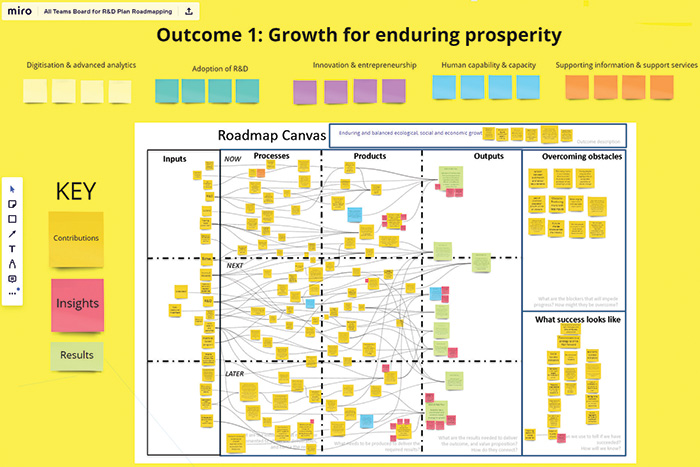The FRDC will begin 2021 with a new roadmap outlining the steps needed to bring to life a new sector-wide vision for Australia’s fishing and aquaculture.
By Catherine Norwood
The FRDC will begin 2021 with a new roadmap outlining the steps needed to bring to life a new sector-wide vision for Australia’s fishing and aquaculture.
Technically, there are five roadmaps, each identifying the steps needed to deliver on the five outcomes in the FRDC’s Research and Development Plan 2020-25. But they all point to a larger goal – a sector-wide vision:
Fish Forever 2030: Collaborative, vibrant fishing and aquaculture, creating diverse benefits from aquatic resources, and celebrated by the community.
The actions identified in the roadmaps will require participation from stakeholders across the four sectors: wild-catch, aquaculture, Indigenous fishers and recreational fishers, as well their various suppliers and participants in the seafood supply chain. The FRDC is just one player needed to address the complex challenges facing the sector.
The larger vision was developed to focus the development of the FRDC’s R&D Plan 2020-25 on working together and striving to create value and achieve more than the acceptable minimum standards.
As the project leader for the R&D Plan, Matt Barwick has also led the development of more detailed roadmaps for the 2030 vision.
He says the long-term target, beyond the life of the current R&D Plan, has allowed those working on the roadmaps to think more broadly about what can be achieved and how to achieve it. It also recognises that time will be needed to address some of the difficult challenges that lie ahead.
The FRDC experimented with an open-to-all engagement process with a series of five online workshops to canvass input into the roadmaps. Smaller, expert committees have further refined the often wide-ranging ideas raised during the workshops. Ongoing consultation with the FRDC’s stakeholder groups, its Research Advisory Committees and those organisations involved in Industry Partnership Agreements and Subprograms will follow.

New process
Matt Barwick says the online roadmapping workshops are the first time the FRDC has undertaken such a planning process, relying on virtual rather than in-person events. While this has been mandated by differing COVID-19-related travel restrictions across the country, it has also allowed diverse participation in the discussion, including people and organisations which had not previously taken part in similar events.
More than 100 participants joined the workshop process, with most attending sessions of specific interest and a few attending all five events.
“One of the things we’re learning from the COVID-19 world is online technologies allow people who have children, or otherwise complex and busy lives, to engage in things they just couldn’t before, because they can do it from their home or wherever they are,” says Matt Barwick. “We’re also refining how we go about providing these kinds of sessions as we go, including addressing some of the technological challenges.”
Each workshop focused on one outcome from the current R&D Plan to develop a roadmap forward. These outcomes are:
- Growth for enduring prosperity;
- Best practices and production systems;
- A culture that is inclusive and forward thinking;
- Fair and secure access to aquatic resources; and
- Community trust, respect and value.
The roadmapping challenge used a reverse-engineering approach, working backwards from the desired outcome.
For each specific R&D Plan outcome, participants considered what results are needed to deliver success, what ‘deliverables’ or products might be needed to achieve those results, and what activities or initiatives are needed to produce those deliverables. Finally, discussion identified the critical inputs required to allow activities to be undertaken.
“What are the critical things that need to be done to enable growth for fishing and aquaculture in social, economic and ecological terms – that’s what we’re trying to identify in the first roadmapping process, focusing on R&D Plan Outcome 1,” says Matt Barwick.
“Then we can explore which of those things the FRDC is well placed to help deliver.
But starting with a broad focus and then narrowing it down enables a more detailed and complete conversation about what is needed, and what each player can contribute to the shared challenge.”

An example of the roadmap canvas developed by participants during the first workshop, which focused on the FRDC’s Outcome 1: Growth for enduring prosperity.
Discussion during the workshop highlighted the ongoing impacts of ‘old wounds’ and conflicts within sectors, between sectors, with resources managers and with vested political and commercial interests committed to protecting the status quo.
Across all of the five workshops, participants identified it would be crucial to address these issues if a vision based on collaboration, forward thinking, inclusiveness and trust is to be achieved.
“Ultimately, if the shared vision is something that people from all sectors can unify behind, the roadmaps help to identify how people can work together to achieve that vision, enabling the FRDC to understand how we can use R&D to assist – that’s our aim. It’s about getting a broader cross-section of the Australian community together to build consensus, awareness and push in the same direction,” Matt Barwick says.
Roadmaps for each of the five outcomes are expected to be launched in January 2021 and will help inform investment under the R&D Plan. However, Matt Barwick points out that roadmaps are ‘living’ documents that can evolve along with further discussion and debate across the sector as a whole, and as progress is made and more is learned.
The new process being undertaken by the FRDC is also a great example of collaboration across the agribusiness systems. Insights collected through the roadmapping process will feed into an initiative by Food Innovation Australia Ltd (FIAL), which aims to help increase the value of Australia’s food and agribusiness sectors to more than $200 billion by 2030.
The roadmaps will also help to inform the development of a National Fisheries Plan.
View the FRDC Research & Development Plan 2020-2025 online on the FRDC’s website.
The roadmapping proccess – an example
Desired outcome: a sustainable, productive food and agribusiness industry.
Result needed to achieve this, or ‘what success looks like’: the prolific use of big data and precision agriculture.
Deliverables on which the result can be achieved: adoption of technologies that support profitable businesses; trusted processes for data sharing.
Activities required to generate these deliverables: creation of incubator programs to accelerate R&D and scale technologies; processes to identify and incorporate the evolving and real-time needs of producers into new products and services.
Initial essential inputs needed to undertake required activities: a workforce with the necessary skills; data standards for the collection, storage and sharing.
More information
Matt Barwick, matt.barwick@frdc.com.au





